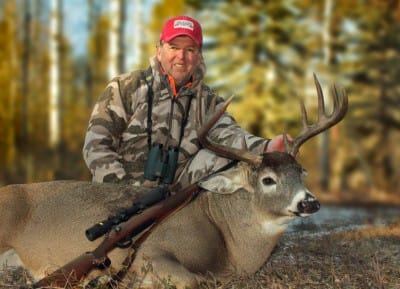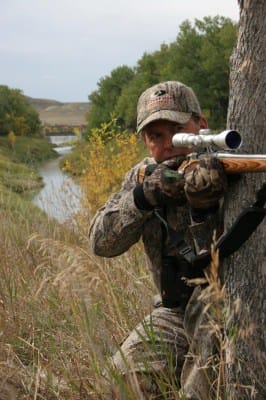
The lucky hunters amongst us will fire one bullet at a good buck this season. Here’s how to make that one shot count.
Think out a shot before it happens. Say you’re walking along on a ridge. What if a buck jumps out of that draw? Which way will he run? Is it 100 or 200 yards across that canyon? Stay sharp and ready and anticipate a quick shot as best you can.
One day I crawled up on a buck bedded in the sunshine, zapped him at 152 yards with my range finder, flipped down the legs of my Harris bipod, fine-tuned aim for 10 seconds and pressed the Model 700’s trigger. I might as well have shot off that deer off a bench. Use a bipod or, at the least, shooting sticks in big country where you have time to set up a shot. When still-hunting in timber where a buck might pop up quickly, the side of a tree or a monopod is a better, faster option.
You need a gun rest in a tree stand, too, you know. I often carry a 3-foot monopod up into my perch and use it for a sitting shot at a buck anywhere out front. I also put a screw-in step on either side of the tree I’m in, about five feet above the foot rest. If a buck angles in from behind, I stand, turn slowly back to the right or left, rest my gun on the step and take him.
In the mental chaos of trying to shoot a big 10-pointer who can remember a fancy wind-doping equation? Remember this simple but logical equation and you’ll do fine: If the wind is blowing lightly at 5 or 10 mph hold dead-on a buck. But if you’re having trouble keeping on your cap, use your gut instinct and aim into the wind a bit on shots past 150 yards. Example: A buck is broadside, looking west into a stout west wind. Aim on the forward point of his shoulder, and let the wind push that bullet back into the boiler room just behind the shoulder.
When is the last time you shot underneath a buck? Uh, never. By far most misses are high because hunters instinctively aim too high in big, open country, even when a buck is only 150 or so yards away. To keep this from happening to you, calm down, take deep breaths and whisper over and over “aim for the heart, aim for the heart” as you line up your shot. It helps to put a bullet low into a deer’s chest.
Once on my Big Deer Blog I posted that in a tense hunting situation most people couldn’t hit an elephant in the butt much past 200 yards. A few guys told me to stick it-they can kill deer all day long at 300 or 400 yards-but most hunters reluctantly agreed I was right. Set up or stalk for rifle shots 200 yards and in (the closer the better) and you’ll do fine every time.

One astute blogger who responded to that aforementioned post said that if you were aiming for an elephant’s butt, you were shooting for the wrong end. Yes, 99 percent of the time you simply aim smack on a buck’s shoulder as he turns broadside, and shoot for the basketball-size lung vitals. One the rare occasion when a deer is chest-on, still and within 150 yards or so, and you don’t anticipate him turning broadside, center the crosshairs on the brisket and press the trigger if you feel confident of making that shot. I don’t like risky neck shots and never take them and do not recommend them.
Once you’ve determined that a buck is a shooter, don’t look at that big rack again or you might get rattled. Take deep breaths, focus on a patch of brown hide on his shoulder and midway up, press the trigger and make that one bullet count.
For a daily dose of deer-hunting information, check out Hanback’s blog at www.bigdeertv.com
The Union Sportsmen’s Alliance website is designed to provide valuable articles about hunting, fishing and conservation for members of AFL-CIO affiliated labor unions and all sportsmen and sportswomen who appreciate hunting and fishing and want to preserve our outdoor heritage for future generations. If you would like your own story and experience from the outdoors to be considered for our website, please email us at[email protected].







